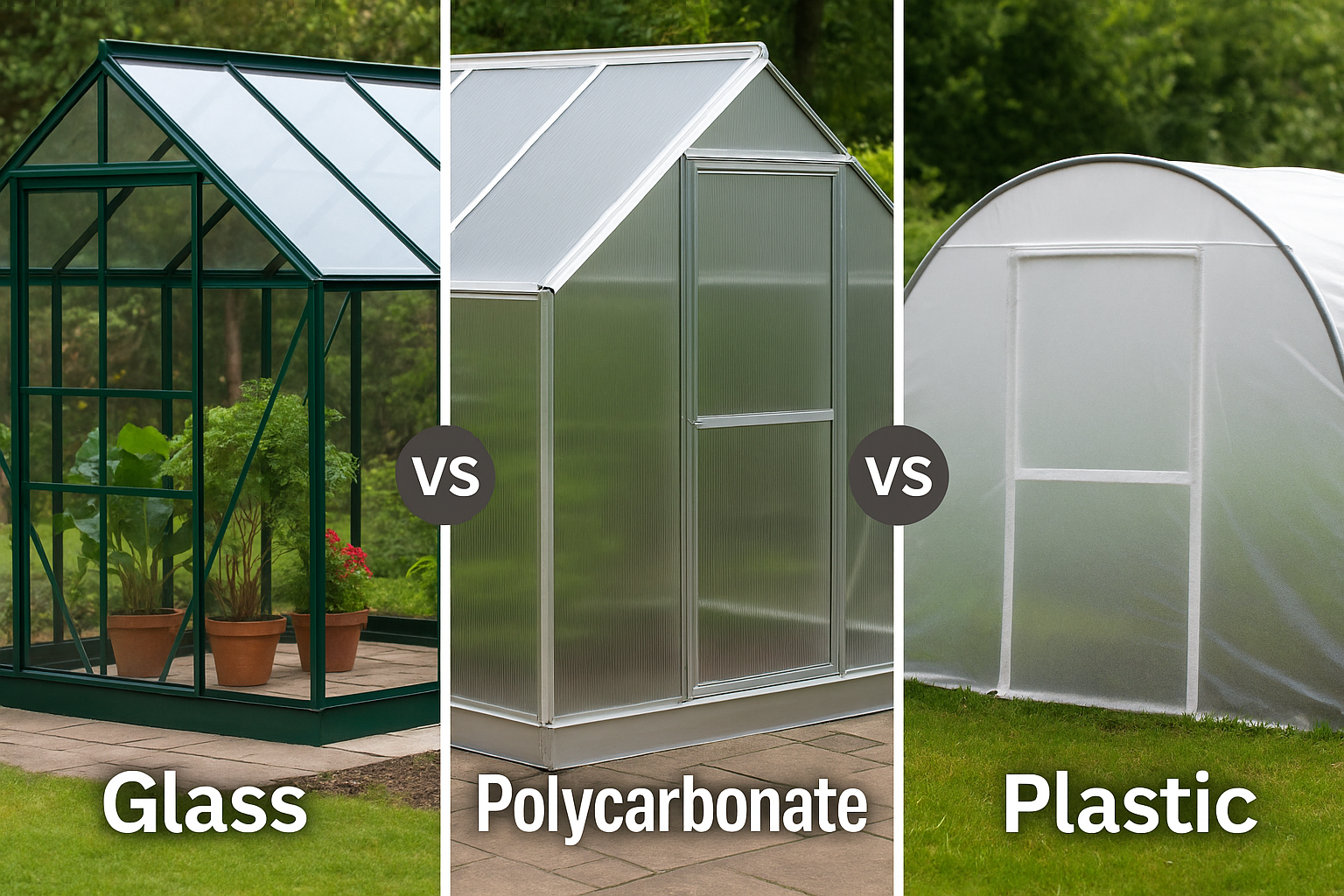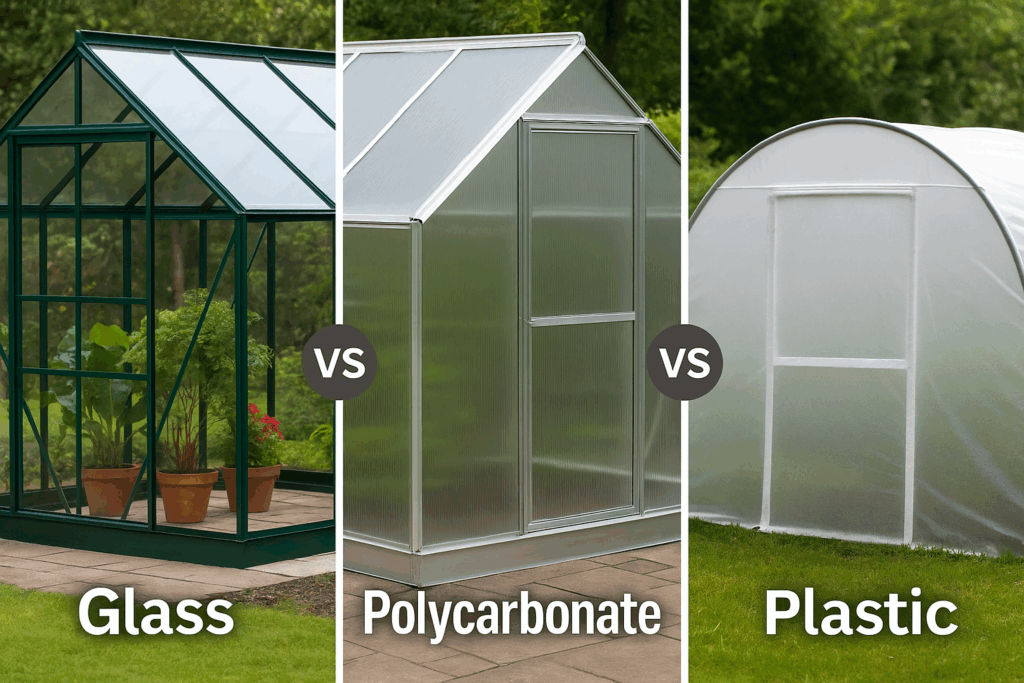
Introduction
Choosing the right greenhouse isn’t just about size or style — the material it’s made from affects how warm it stays, how long it lasts, and how safe and sustainable it is.
When looking to choose the best type of greenhouse, you will be deciding between glass, polycarbonate, plastic film, wood, or metal. Each material has clear pros and cons depending on your garden, climate, and family needs – and in this guide, we’ll help you make the right choice.
Once you know which type suits you, take a look at our in-depth guides:
👉 Best Mini Greenhouses UK
👉 Best Small Greenhouses UK
Looking for more guides and comparisons? Visit our Greenhouses & Polytunnels UK Resource Hub for everything from mini models to full-size structures.
Comparison Table
| Material | Appearance | Insulation | Durability | Maintenance | Cost | Lifespan | Eco-friendly? | Kid-safe? |
|---|---|---|---|---|---|---|---|---|
| Glass | Classic, clear | Excellent | Fragile | Low | £££ | 20–30 years | Fully recyclable; energy-intensive to make | ✖ Fragile – not ideal around children |
| Polycarbonate | Frosted, modern | Very good | High | Low | £ | 10–15 years | Partly recyclable; long lifespan reduces waste | ✔ Safer than glass |
| Plastic film | Flexible, lightweight | Moderate | Short lifespan | Low | £ | 2–4 years | Not eco-friendly, but frames reusable | ✔ Soft, no sharp edges |
| Wood frame | Natural, rustic | Good | Moderate | Needs care | £££ | 10–30 years (longer if maintained) | Renewable material; can rot if untreated | ✔ Generally safe |
| Metal frame | Modern, sleek | Average | Very high | Minimal | ££ | 15–25 years | Recyclable and long-lasting | ✔ No glass to shatter |
🪟 Glass Greenhouses
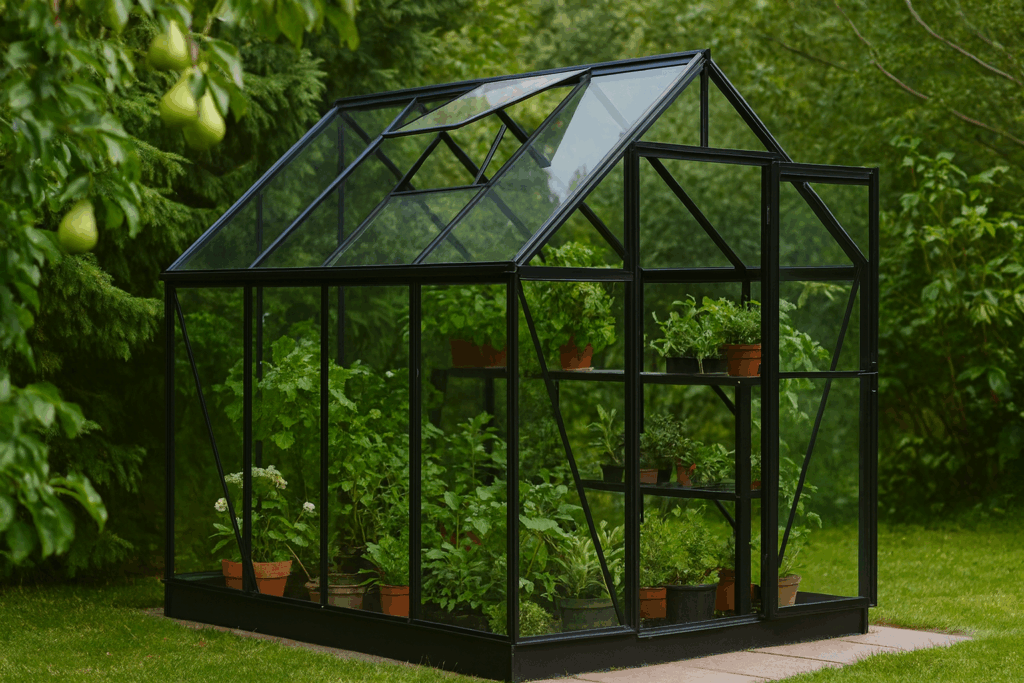
Glass is the traditional choice for gardeners seeking a timeless look and superb light transmission.
- Lifespan: 20–30 years (frames may last longer).
- Maintenance: Minimal — just clean glass panels and ensure seals are intact.
- Eco note: Glass is 100% recyclable, but manufacturing is energy-intensive and shipping heavy panes adds emissions.
- Kid safety: Not ideal for gardens with young children — glass can shatter, even if toughened.
- Cost: High
Glass greenhouses remain a beautiful, permanent option for dedicated gardeners who value clarity and longevity over portability or child safety.
🌫️ Polycarbonate Greenhouses
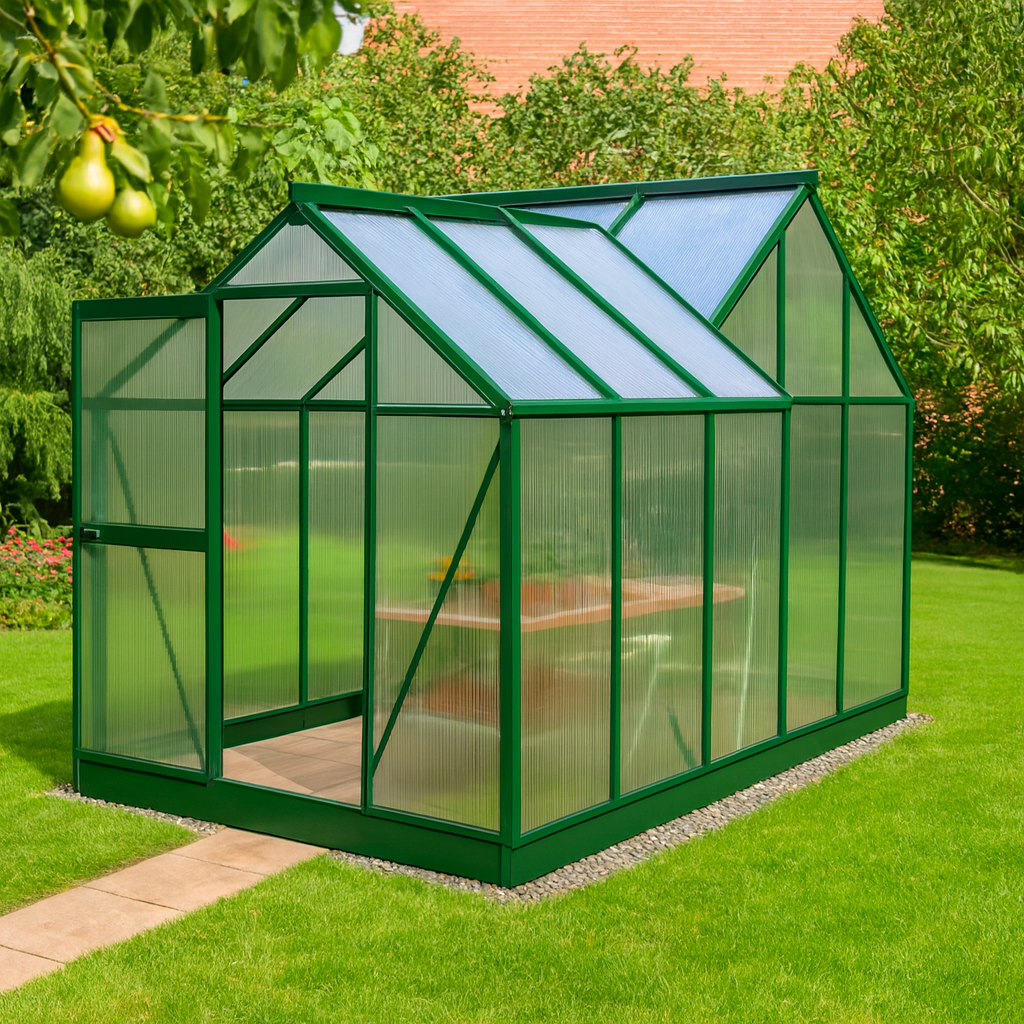
Polycarbonate has become the most practical modern material, offering excellent insulation and impact resistance.
- Lifespan: 10–15 years (UV-treated panels can last longer).
- Maintenance: Occasional washing to prevent algae and dust build-up.
- Eco note: Technically recyclable, though limited UK facilities handle it; its long lifespan offsets that impact.
- Kid safety: Much safer than glass — panels are flexible and don’t shatter.
- Cost: Moderate
Polycarbonate greenhouses are energy-efficient, safe, and durable — a brilliant all-rounder for family gardens and variable UK weather.
🧴 Plastic Film Greenhouses
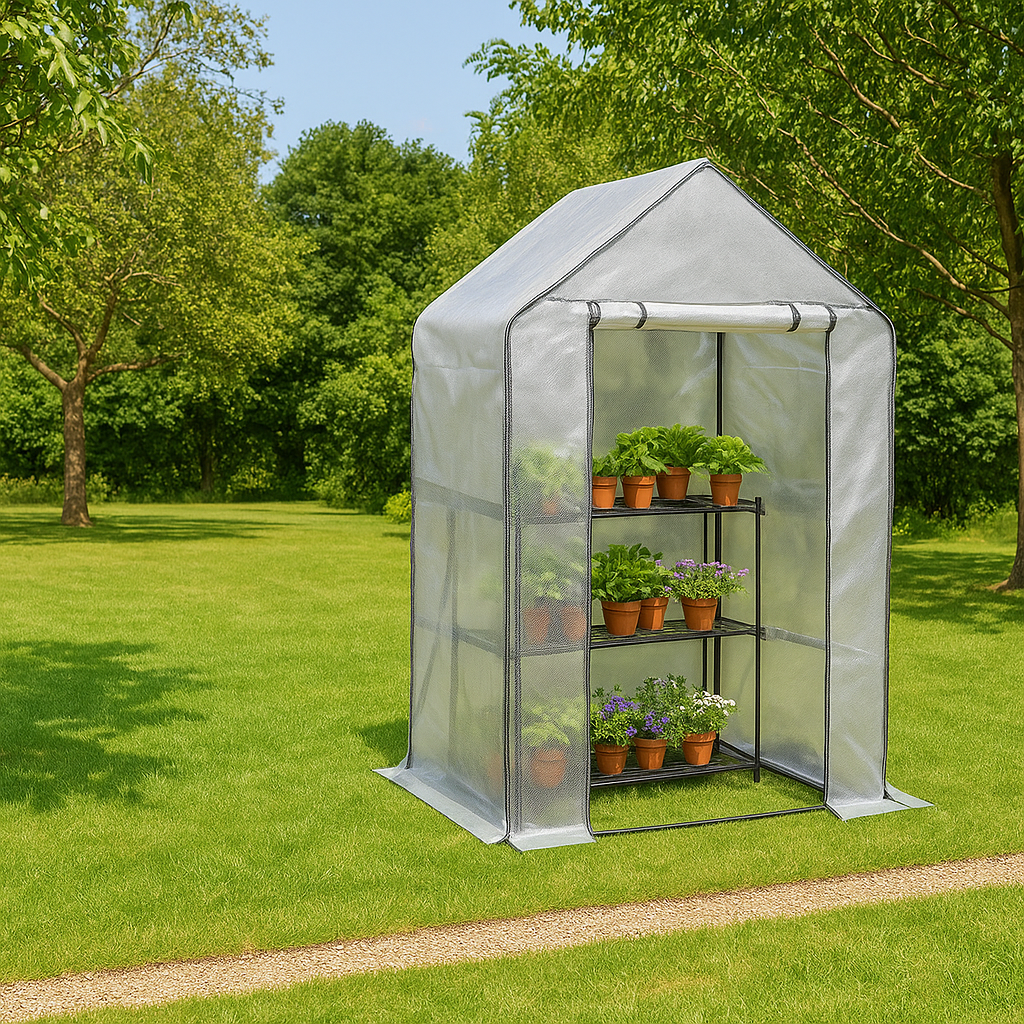
Plastic film greenhouses (or “pop-up” types) use a thin polyethylene cover over a metal or fibreglass frame.
- Lifespan: 2–4 years for covers (frames can last 5–10).
- Maintenance: Replace covers periodically and secure against wind.
- Eco note: Polyethylene isn’t easily recyclable, but the small amount of material used means less waste overall.
- Kid safety: Excellent — no glass, soft edges, lightweight.
- Cost: Cheap
They’re ideal for beginners, renters, or balcony growers who want quick setup and flexibility, though not great for winter use or sustainability.
🪵 Wooden Frame Greenhouses
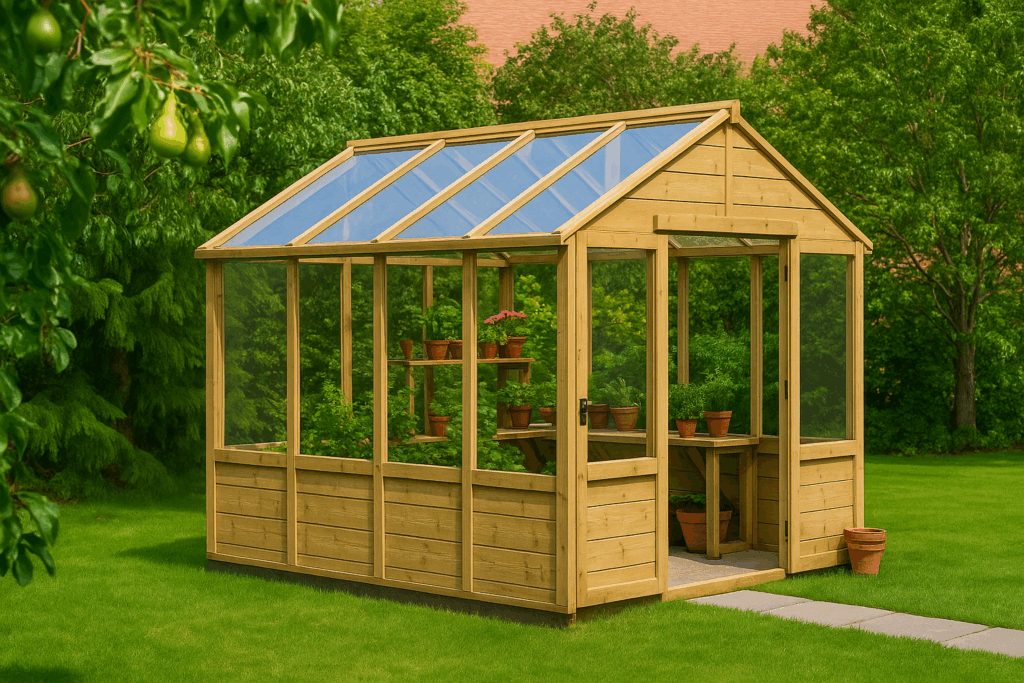
A wooden greenhouse blends natural looks with decent insulation and a sturdy frame.
- Lifespan: Around 10–15 years if treated annually.
- Maintenance: Needs regular painting or wood preservative to prevent rot.
- Eco note: Wood is renewable and biodegradable, making this the most eco-friendly choice if sustainably sourced (look for FSC-certified timber).
- Kid safety: Generally safe — no shattering materials, but check for splinters or sharp edges as wood ages.
- Cost: High
Wooden greenhouses are perfect if you value sustainability and aesthetics, and don’t mind a touch of maintenance each spring.
🧱 Metal Frame Greenhouses
Most metal greenhouses use aluminium — strong, rustproof, and lightweight.
- Lifespan: 15–25 years or more with minimal upkeep.
- Maintenance: Virtually none — just tighten bolts and clean.
- Eco note: Aluminium is fully recyclable and can be reused endlessly, making it surprisingly sustainable over time.
- Kid safety: Very good — sturdy structure and no shattering panels.
- Cost: Moderate
Metal frames are the most durable and low-maintenance option, ideal for exposed gardens or long-term growers who want a once-and-done structure.
🌤️ Which Type of Greenhouse Is Best Overall?
| Goal | Best Choice |
|---|---|
| Longest lifespan | Glass or metal |
| Best insulation | Polycarbonate |
| Most eco-friendly | Sustainably sourced wood or long-lasting aluminium |
| Safest for kids | Polycarbonate or plastic film |
| Best for beginners | Plastic film |
| Lowest maintenance | Aluminium frame |
| Most permanent | Glass or polycarbonate with metal frame |
If you’re unsure, a polycarbonate-panel greenhouse with an aluminium frame offers the best blend of safety, sustainability, and long-term value for most UK gardeners.
You can explore top-rated examples in our guides to the Best Mini Greenhouses UK and Best Small Greenhouses UK.
Or see our guide to Greenhouse vs Polytunnel to compare other structures.
Final Thoughts
Whether you’re starting small or planning a permanent structure, choosing the best type of greenhouse depends on your growing goals, space, and how much maintenance you’re happy to do. For most UK gardeners, a polycarbonate greenhouse offers the best all-round balance of safety, insulation, and long-term value.
Looking for more self-sufficiency and gardening guides? Visit HomeGrower to explore our latest advice on mini greenhouses, indoor growing, and outdoor garden tips.
HomeGrower.co.uk is reader supported. As an Amazon Associate, we earn from qualifying purchases. This comes at no extra cost to you and helps us keep producing free, independent gardening advice.
FAQs About Choosing the Best Type of Greenhouse
What is the best type of greenhouse overall?
The best type of greenhouse depends on your climate and budget. For most UK gardeners, a polycarbonate model offers the best balance of insulation, durability, and cost. It’s safer than glass and holds warmth better in winter.
Is glass or polycarbonate better for a greenhouse?
Both have advantages. Glass greenhouses give perfect light clarity and a classic look, while polycarbonate greenhouses retain more heat and are less fragile — making them a better choice for families or windy locations.
What is the best type of greenhouse for beginners?
If you’re new to growing, a plastic or polycarbonate greenhouse is best. These are cheaper, lighter, and easier to assemble than traditional glass models, so you can learn without major investment.
Which type of greenhouse lasts the longest?
A well-built glass or metal-framed greenhouse can last 20–30 years with minimal maintenance. Polycarbonate models typically last 10–15 years, while plastic film options need replacing every few seasons.
What’s the most eco-friendly type of greenhouse?
The most eco-friendly greenhouse uses renewable or recyclable materials — such as FSC-certified wood or aluminium frames with polycarbonate panels. These offer sustainability and long lifespan with minimal waste.
Is the best type of greenhouse safe for children and pets?
Yes. If safety is a concern, choose a polycarbonate or plastic greenhouse — both are shatterproof and lightweight. Avoid glass greenhouses if kids play nearby.
Which type of greenhouse keeps the most heat?
Polycarbonate panels trap heat efficiently thanks to their air gaps, making them ideal for cooler UK climates. Glass lets in more light but loses warmth faster at night.
How do I choose the best type of greenhouse for my garden?
Consider size, budget, and how permanent you want your setup to be. A polycarbonate or metal-framed greenhouse suits long-term growing, while plastic walk-ins are perfect for renters or small gardens.
